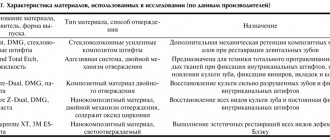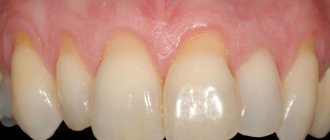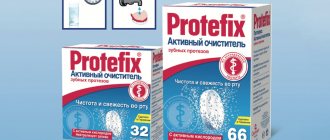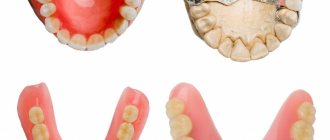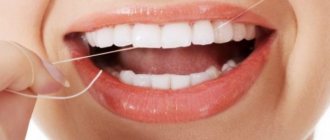Causes
The pathology is caused by numerous infectious agents, as well as oral injuries and allergic reactions. The reason for its development may be a lack of certain vitamins and microelements.
The following types are distinguished:
- viral (herpetic - present in 80% of all cases, the rest are represented by measles, chickenpox, influenza, rubella, mononucleosis, adenovirus, enterovirus, papillomavirus viruses);
- fungal – candidiasis is detected in the vast majority of cases in infants; in older children it occurs due to immunodeficiency, diabetes, or taking antibiotics;
- bacterial - most often it is caused by various types of staphylococci and streptococci; in rare cases, stomatitis is caused by pathogens of tuberculosis, syphilis, diphtheria, gonorrhea;
- allergic – often the pathology develops as a reaction to various products, components of toothpaste, chewing gum;
- autoimmune – in the occurrence of aphthous lesions, one of the leading causes is considered to be the presence of autoimmune problems;
- traumatic - in children, the oral mucosa is less stable than in adults; it is easily damaged under the influence of chemical and physical agents, or mechanical trauma.
The factor that caused this pathology determines the treatment tactics and what drugs will be prescribed.
There are factors that contribute to the development of the disease.
These include:
- diseases of the gastrointestinal tract (duodenitis, gastritis, intestinal dysbiosis, colitis, enteritis);
- blood diseases;
- pathologies of the nervous and endocrine systems;
- helminthiases;
- prematurity;
- insufficient oral hygiene;
- weak local immunity;
- lack of microelements, vitamins (B vitamins, selenium, zinc).
All these numerous factors cause and contribute to the development of stomatitis. In this regard, there is a significant difference in the treatment of different types of disease.
Advice one. Whiten your teeth with hydrogen peroxide.
Do not under any circumstances try to restore the whiteness of your smile using this aggressive chemical composition! Yes, statements that compounds based on hydrogen peroxide are actively used in dentistry are indeed justified. But in the doctor's office you will receive a carefully selected dosage of a special mixture, where peroxide does not occupy a primary place. At best, when using peroxide at home, you will not get any results at all. In the worst case, you will burn your oral cavity, damage the enamel, and for a long time you will get rid of the consequences of your own indiscretion.
Kinds
Varieties are distinguished according to the depth of damage to the mucous membrane and the reasons that caused the development of the pathology.
According to the depth of the lesion there are:
- aphthous;
- catarrhal;
- necrotic;
- ulcerative
Treatment varies depending on the stage. For the catarrhal variety, local treatment at home is predominantly prescribed. With the most severe necrotic, the child is hospitalized in a hospital.
Clinical manifestations of different types of disease
Signs of stomatitis in children vary significantly. This depends on the nature of the agent causing the disease.
Signs of this pathology:
- Viral - this type of pathology is characterized by the appearance of bubbles with a clear liquid that quickly open. Then erosive areas of round shape and small size are formed. They are covered with a grayish coating. In severe cases, the lesion has a draining character. The mucous membrane of the oral cavity and nasopharynx is bright red. There is pronounced pain. Similar skin rashes are also noted. The child shows signs of general intoxication and elevated body temperature. Signs of enlarged lymph nodes and conjunctivitis are detected. Possible loose stools and vomiting. Mucosal defects are epithelialized without scarring.
- Fungal - most of this species is candidal. It often develops in infants. It can also appear in children wearing braces. In other cases, its occurrence indicates immunodeficiency or other severe somatic pathologies. On the surface of the mucous membrane, areas covered with white plaque appear, then its area increases. A dense white layer covers the entire oral cavity; it has a curd-like consistency. In severe forms, it becomes gray and sometimes separates, exposing the bleeding surface. With the atrophic variety of the disease, only redness and dryness of the mucous membrane are detected. Plaque appears rarely, only in folds.
- Bacterial - the most common type of infection is the impetiginous type. It is characterized by confluent superficial erosive lesions and a purple color of the mucous membranes. Yellowish crusts form that stick the lips together. Salivation increased. There is an unpleasant odor from the mouth. Body temperature rises.
- Autozny - this variety is more common in children under 7 years of age. It is assumed that it is of an infectious-allergic or autoimmune nature. With it, aphthae appear on the mucous membrane - these are painful ulcers of a necrotic nature. They are round in shape, covered with fibrin, surrounded by a reddish granulation rim. The child's temperature rises, he is bothered by pain in his mouth, and refuses to eat. This option has a chronic course. Typically, exacerbations occur once or twice a year. Outside of exacerbation, aphthae heal.
Symptoms in children are quite varied. They depend on the form of the disease and the pathogen that caused it.
Diagnostics
If a mucosal lesion occurs in the mouth, the patient is examined by a dentist, infectious disease specialist or pediatrician. To identify the cause of the disease, measures are taken to identify the causative agent of the disease.
The following diagnostic methods are used:
- linked immunosorbent assay;
- cytopolymerase reaction;
- tank sowing discharge from ulcers, pieces of mucous membrane and plaque;
- cytological, immunological research methods.
If candidal stomatitis is suspected, an endocrinologist is consulted and tests are performed to detect diabetes mellitus.
In chronic forms of the disease, the following is carried out:
- tests for worm eggs;
- Ultrasound of the abdominal area;
- immunogram;
- stool examination for dysbacteriosis.
Consultations with a gastroenterologist and immunologist are carried out.
Treatment of various types
After identifying the cause of the disease and identification, stomatitis in children is immediately treated. Self-medication is unacceptable; only a doctor can recommend medications and determine the duration of their course. General and local methods are used for treatment. For a sick child, in addition to treating the disease, dietary nutrition is important. Food should be pureed and not irritate the mucous membranes. The food your baby eats should be at room temperature. Before meals, regardless of the type, painkillers are used (Kalgel, Kamistad).
Treatment of viral stomatitis
For the treatment of viral stomatitis, primarily hermetic, antiviral drugs are used (Oxolinic ointment, Zovirax, Acyclovir, Valtarex, Tebrofen ointment). They lubricate the mucous membranes in the baby’s mouth up to four times a day.
In addition to antivirals, other medications are used:
- antiseptics (Miramistin, Vinilin, Sodium Tetraborate) - they are used to treat the oral mucosa, rinsing is carried out up to four times a day;
- complex drug Viferon - contains interferon, antiseptics, vitamins E and C, it is applied to the affected mucosa for ten days;
- immunomodulators (Sodium Nucleinate, Immunal, Amiksin) – strengthen general and local immunity, used for a course of up to two months;
- anti-inflammatory and antipyretic drugs (Nurofen, Paracetomol) are used to reduce fever and inflammation;
- antihistamines improve the general condition of the baby (Tavegil, Suprastin).
You can use herbal preparations (Stomatidin, Karotolin, Rotokan) that have anti-inflammatory and healing properties
Treatment of candidal stomatitis
Antifungal drugs play a leading role in treatment.
These include:
- Pimafucin;
- Fluconazole;
- Clotrimazole;
- Candide in solution.
The oral cavity is treated several times a day using a moistened cotton pad.
The following products are also used for home treatment:
- soda solution;
- boric acid solution;
- decoction of string;
- sage;
- daisies.
Rinses with these liquids are used. Then use a cotton swab to remove the fungal plaque.
Treatment of aphthous stomatitis
Along with diet, medications and external agents are used for treatment. The disease is severe, so treatment is prescribed only by a doctor.
The following medications are used:
- antihistamines (Suprastin, Citrine, Zodak) - they relieve allergic manifestations by blocking inflammatory mediators;
- antiviral drugs (Tamiflu, Arbidol, Remantadine) - help fight viruses that cause the formation of canker sores;
- vitamin complexes (Pikovit, Alphabet) to strengthen the immune system;
- gels for pain relief of ulcers (Instillagel, Kalgel, Kamistad) are used up to four times a day, they are lubricated with the oral mucosa in the affected areas;
- for rinsing, use herbal decoctions (peppermint, calendula, sage) - they are used every four hours;
- To accelerate the epithelization of ulcers, sea buckthorn oil is used, it is used up to three times a day;
- Aloe juice effectively heals aphthae in the oral cavity; to do this, take pieces of the leaf, cut in half and wipe the inside of the mucous membrane three times a day.
If treatment does not improve, the doctor prescribes antibiotics and glucocorticoid drugs.
Treatment of bacterial stomatitis
Medicines for this stomatitis are prescribed by a doctor. Antibiotics are used after studying the sensitivity of bacteria to various antibiotics, and the most effective one is selected. In addition to them, immunostimulants, antiseptics, and anti-inflammatory drugs are used.
These include:
- antiseptic solutions and sprays (Chlorhexidine, Tantum Verde, Hexaral) - the oral cavity is treated with these products after each meal, but no more than six times a day;
- Decoctions of herbs (cinquefoil, chamomile, St. John's wort) are also useful - you should rinse your mouth with them in between antiseptics;
- treatment of affected surfaces with hydrogen peroxide has a positive effect;
- Metrogyl Denta - gel is an antibiotic, used for treatment until the sensitivity of bacteria to antibiotics is determined;
- Lidochlor, Vinilin, Eucalyptus M are used for pain relief and restoration of the mucous membrane.
It is also advisable to use immunostimulating drugs to speed up recovery after suppression of the bacterial flora.
Treatment of traumatic stomatitis
Therapy for this lesion should begin immediately and be comprehensive.
The following drugs are used for treatment:
- antiseptics (hydrogen peroxide, Furacillin solution, calendula tincture) - they treat the affected areas;
- To prevent replenishment, anti-inflammatory antimicrobial drugs (Lugol, Hexalize, Miramistin, Cholisal) are used; surfaces can be treated up to six times a day;
- painkillers (Kamistad, Lidocaine Asept) - applied to the surface twice a day;
- drugs that promote healing (Rotocan, Chlorophyllipt) - they are lubricated with the affected mucous membrane up to three times a day.
When there is permanent mechanical injury, it must be eliminated. Chipped teeth are treated and orthodontic appliances are adjusted.
Other recipes with hydrogen peroxide for periodontal disease
You can add soda or lemon to the peroxide. According to reviews, treating periodontal disease at home with hydrogen peroxide will be much more effective if you combine it with other ingredients.
For example, rinsing with sea salt and peroxide will help relieve inflammation. For this, 1 tsp is enough. Dilute both in a glass of warm water, and then rinse in the usual way. Herbal infusions are also used to treat and prevent gum disease. In this case, infusions of oak bark, sage, St. John's wort and plantain are suitable. Add 5-10 drops of peroxide to the prepared broth and rinse your gums with it. It is necessary to add peroxide to the glass immediately before the procedure, when the herb has infused for the allotted time and the decoction itself becomes less hot.
With soda
Hydrogen peroxide and soda are one of the popular methods for treating periodontal disease at home. To prepare the solution you will need dry peroxide, and it is better to use sea salt. If it is coarsely ground, make sure that it is completely dissolved in the water. Under no circumstances should the prepared solution be swallowed.
Ingredients:
- Dry peroxide - 2 tablets.
- Salt - 1 tsp.
- Water - 200 ml.
How to prepare : Mix all ingredients.
How to use : Rinse your mouth with the resulting solution 3-4 times a day. The duration of the procedure is 5 minutes. The course of therapy is 1 month.
Result : Washes away pathogenic microorganisms from the surface of the gums, stops bleeding, promotes the regeneration of soft tissues.
With lemon
At home, periodontal disease can be treated with hydrogen peroxide, baking soda and lemon. This product can replace toothpaste. You should not do this regularly - for prevention purposes, one procedure every 7-10 days is enough.
Ingredients:
- Baking soda - 3 g.
- Lemon juice - 10 drops.
- 3% hydrogen peroxide - 20 drops.
How to prepare: Add fresh citrus juice to the soda and stir thoroughly. Then add peroxide.
How to use : Brush your teeth with the resulting mixture; no need to rinse your mouth. After the procedure, you should not eat or drink for at least 15 minutes.
Result : Heals gums, promotes periodontal regeneration.
Prevention
The occurrence of stomatitis is much easier to prevent. To do this, just follow simple rules.
Recommended:
- clean your mouth twice a day under parental supervision;
- regularly take your child to the dentist for preventive examinations;
- promptly treat dental caries;
- avoid injury to the oral mucosa;
- timely treat all somatic diseases in the baby;
- disinfect dishes and toys;
- prohibit the baby from putting dirty objects and hands in his mouth.
Stomatitis has different origins and is caused by different pathogens. Therefore, only a doctor should treat these diseases. Self-medication is unacceptable, since a thorough diagnosis is necessary before treatment. Identification of the causative agent of the disease is a condition for successful treatment.
Contraindications for rinsing
Rinsing the mouth with a solution made from hydrogen peroxide is allowed during pregnancy and breastfeeding.
The use of the medicine should be discontinued if the following contraindications exist:
- individual intolerance to the components present in the composition of the drug;
- advanced stage of periodontitis;
- simultaneous use of antibiotics;
- fragility of tooth enamel.
